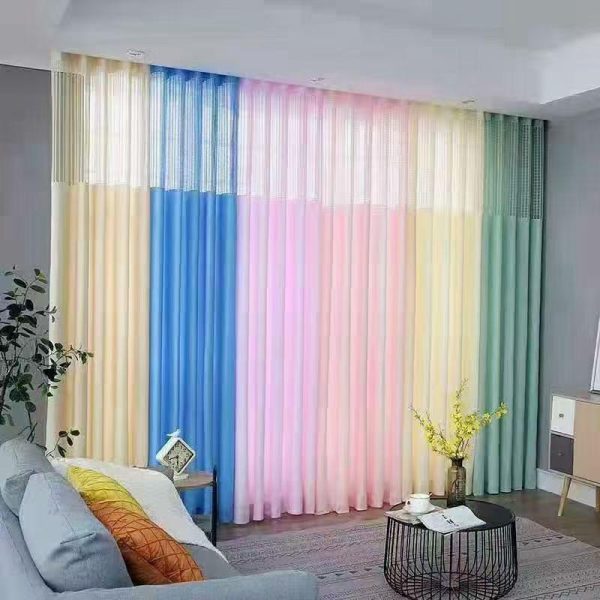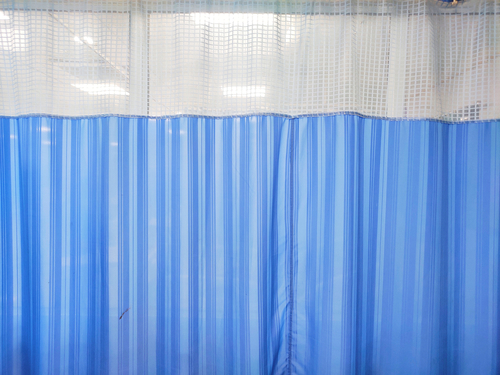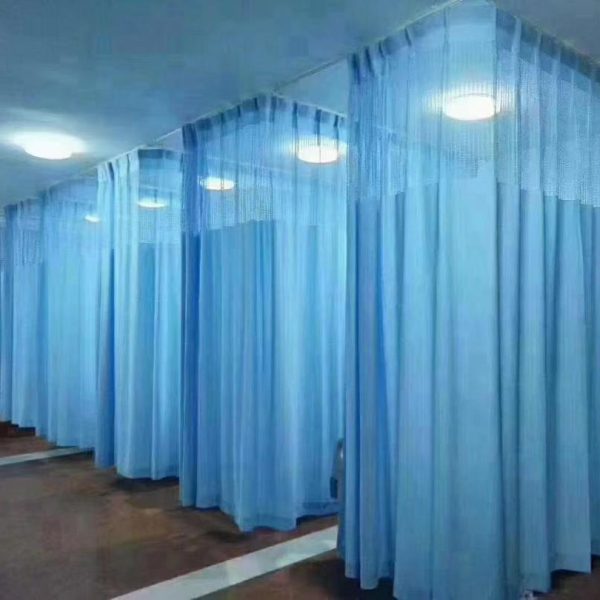Description
Disposable hospital curtains are single-use fabric panels used to create temporary partitions in healthcare settings.
They provide privacy for patients during examinations and procedures and help control infection by preventing the spread of germs. And can also be used to designate clean and contaminated areas.
Disposable Hospital Curtains are designed to replace reusable curtains in hospitals or healthcare facilities where privacy and patient screening are required.
They eliminate the tedious and costly process of washing untreated, reusable curtains. And can be left on at fixed intervals for up to a year. But this depends on the risk of infection in the areas where they are hung. This is possible because antibacterial chemicals injected into the fabric actively inhibit bacterial growth.
How much does it cost you to wash hospital curtains? What advantages do disposable curtains have over permanent reusable hospital curtains? Can disposable curtains be reused?
Without a doubt, these are some of the questions that are asked in hospitals and clinics. Because infections among people occur a lot due to insufficient hand hygiene.
This concern is always a battlehorse among hospital staff. And that is why preventive measures and the materials used in these centers are taken into account.
Taking these aspects into account, the costs of maintaining a permanent hospital curtain require complex and very thorough processes in terms of laundry.
This is unlike disposable or single-use curtains that do not have to go through any cleaning process.
Shower curtains
Disposable shower curtains are liners made from materials like polyethylene or nylon that are designed to be used once and then thrown away.
They’re often used in hospitals, nursing homes, and other healthcare facilities to help prevent the spread of germs and bacteria. They can also be useful for camping, traveling, or for temporary use in a home bathroom.
Here are some of the pros and cons of using disposable shower curtains:
Advantages of disposable shower curtains
Hygienic
Disposable shower curtains are a good option for preventing the spread of germs and bacteria, especially in places where hygiene is a concern, like hospitals and nursing homes.
Convenient
Disposable shower curtains are easy to use and don’t need to be cleaned or laundered. You simply throw them away after each use.
Portable
Disposable shower curtains are lightweight and easy to transport, making them a good option for camping, traveling, or for temporary use in a home bathroom.
Disadvantages
Wasteful
Disposable shower curtains are not environmentally friendly, as they create waste each time they are used.
Expensive
Disposable shower curtains can be more expensive than reusable shower curtains in the long run.
Less durable
Disposable shower curtains are not as durable as reusable shower curtains and may tear or rip more easily.
If you’re considering using disposable shower curtains, it’s important to weigh the pros and cons carefully. If hygiene is a top concern, or if you need a temporary solution, disposable shower curtains may be a good option. However, if you’re looking for an environmentally friendly or cost-effective option, reusable shower curtains are a better choice.
The cost of disposable hospital curtains
Disposable curtains are typically cheaper upfront than reusable curtains. But the main factor influencing cost is how often you need to replace the curtains. If you use them for every patient, the cost can add up quickly. In high-traffic areas, you might need to replace them daily, while in low-traffic areas, you might be able to get away with replacing them weekly or even monthly.
Some disposable curtains can be recycled, but many end up in landfills, adding to environmental costs.
Reusable versus disposable hospital curtains
The debate over whether to use disposable or washable curtains in a healthcare setting has been a dilemma for hospital and GP surgery purchasers for years. Reusable curtains are more expensive upfront than disposable curtains.
Cleaning and maintenance costs
You’ll need to factor in the cost of laundering or dry cleaning the curtains. And which can vary depending on your facility’s laundry services and the frequency of cleaning.
Lifespan
Reusable curtains can last for years, depending on the quality and how well they are cared for. This can offset the higher initial cost compared to disposables.
Ultimately, the most cost-effective option for your facility will depend on your specific needs and usage patterns. Consider the following factors when making your decision:
- Traffic volume: If you have high-traffic areas where curtains need to be replaced frequently, disposables might be more cost-effective.
- Infection control: If infection control is a top priority, reusables might be a better option, as they can be thoroughly disinfected between uses.
- Sustainability: If you’re concerned about the environmental impact, reusables are the clear winner.
- Budget: If you have a tight budget, disposables might be the more affordable option.
Can disposable curtains be reused?
Generally, disposable hospital curtains are not designed for reuse and should not be reused for several reasons:
Hygiene
The primary purpose of disposable curtains is to provide a clean and hygienic barrier for each patient. Reusing them increases the risk of cross-contamination and spreading germs between patients.
Durability
Disposable curtains are made of lightweight materials like non-woven polypropylene or polyethylene. And which are not meant to withstand multiple uses. They can tear, rip, or lose their flame retardancy properties after being cleaned or used again.
Sanitization
While some materials may be technically cleanable, proper sanitation for hospital use often requires high temperatures and harsh chemicals, which could damage the material or compromise its fire-resistant properties.
Regulations
Depending on your region and specific healthcare setting, regulations may prohibit the reuse of disposable curtains due to infection control concerns.
However, there are a few specific cases where limited reuse might be acceptable:
Low-risk areas
If the curtains are used in non-clinical areas with minimal risk of infection, like waiting rooms or administrative offices, limited reuse might be considered. Thorough cleaning and disinfection between uses would still be necessary.
Emergencies
In situations where disposable curtains are unavailable and patient privacy is crucial, a single reuse might be necessary as a temporary measure. Again, thorough cleaning and disinfection afterward are essential.
It’s important to always check with your local healthcare regulations and infection control guidelines before considering any form of reuse for disposable hospital curtains. The potential risks for infection and patient safety outweigh any slight cost savings from reuse in most cases.
Advantages and disadvantages
Disposable hospital curtains offer a convenient and hygienic solution for patient privacy and infection control.
However, like any product, they also have drawbacks. Here’s a breakdown of the pros and cons to help you decide if they’re the right fit for your healthcare facility:
Advantages
- Infection Control: Disposable curtains eliminate the need for laundering, reducing the risk of cross-contamination and the spread of germs. This is especially beneficial in high-risk areas like isolation rooms or operating theaters.
- Convenience: Disposables are quick and easy to set up and take down, requiring minimal staff time and effort. This is particularly helpful during emergencies or for quick patient examinations.
- Cost-Effective (Initially): Compared to reusables, disposables have a lower upfront cost per curtain. This can be attractive for budget-conscious facilities.
- Variety: They come in various sizes, colors, and materials to suit different needs and preferences. Some even have flame-retardant or antimicrobial properties for added safety.
- Cleanliness Perception: Fresh, new curtains for each patient can contribute to a positive perception of cleanliness and hygiene in your facility.
Here are some key scenarios where disposable curtains shine:
- Outbreak Situations: During outbreaks of highly contagious diseases like MRSA or influenza, disposable curtains can be frequently replaced to minimize the risk of cross-contamination. This is especially crucial in isolation rooms and quarantine areas.
- High-Risk Procedures: For procedures with a high risk of bodily fluid exposure, such as surgery or wound care, disposable curtains provide an extra layer of protection against the spread of pathogens.
- Contaminated Curtains: If reusable curtains become soiled or stained with bodily fluids, they may harbor bacteria even after cleaning. In such cases, disposable curtains offer a safer alternative, eliminating the risk of missed decontamination.
-
Rapid Deployment: In temporary medical facilities or during emergencies, disposable curtains can be quickly installed and taken down without needing specialized cleaning or laundering. This is particularly helpful in disaster relief or surge situations.
-
Travel and Transport: For medical missions or outreach programs in remote areas, disposable curtains are lightweight and easy to transport, simplifying logistics and setup.
- Allergic Patients: Some patients may have allergies to the materials used in reusable curtains. Disposable curtains made from hypoallergenic materials like non-woven polypropylene can provide a safer and more comfortable environment.
- Burn Units: In burn units, where patients’ skin is especially vulnerable to infection, disposable curtains can further minimize the risk of contamination.
- Psychological Comfort: For patients who value privacy or feel uneasy with reusable curtains, disposable options can offer a sense of freshness and cleanliness, potentially improving their psychological well-being.
Additional Considerations:
- Environmental Impact: While convenient, disposable curtains generate waste. Choosing sustainably sourced and biodegradable materials can help minimize their environmental footprint.
- Cost-Effectiveness: When used frequently, the cost of disposable curtains may outweigh the long-term savings associated with reusable ones. Careful evaluation is crucial for each facility.
Disadvantages
-
Environmental Impact: Disposables generate waste, contributing to landfill burdens and plastic pollution. Eco-friendly alternatives like recycled or biodegradable materials are emerging, but traditional disposables are not sustainable.
-
Durability: They are not as durable as reusable curtains and may tear or rip more easily, requiring more frequent replacements. This can increase long-term costs.
-
Flame Retardancy: Some disposable curtains may not meet the same flame retardancy standards as reusables, posing a potential safety risk in healthcare settings.
-
Comfort: The material used in disposables can be less breathable and comfortable than the fabric used in reusables, especially for patients who need to spend extended periods behind the curtain.
-
Hidden Costs: While the initial cost per curtain is lower, frequent replacements due to low durability can lead to higher overall costs in the long run.
Ultimately, the decision of whether to use disposable or reusable hospital curtains depends on your specific priorities and needs. Consider factors like infection control requirements, budget constraints, environmental impact, and patient comfort when making your choice.
How to dispose of medical curtains
The best way you can dispose of medical curtains depends on the materials they’re made of and any potential contamination they might have.
Here are some safe and responsible methods:
If the curtains are clean and uncontaminated
Check with local hospitals, clinics, or nursing homes if they could use the curtains and donate. Some animal shelters also accept fabric donations for bedding. If the curtains are made from recyclable materials like polyester or cotton, check with your local recycling program. Or search for textile recycling facilities near you.
You can also repurpose the curtains. Get creative! You could turn the curtains into tote bags, reusable shopping bags, or other fabric goods.
If the curtains are contaminated with bodily fluids or infectious agents
Follow medical waste disposal guidelines. You can consult your local healthcare facility or waste disposal company for specific instructions on how to safely dispose of contaminated medical waste. This might involve using designated containers or bags and following specific transportation and disposal protocols.
Do not attempt to dispose of them in your regular trash. Because contaminated medical materials can pose a health risk to sanitation workers and others who come into contact with them.
Here are some additional tips for safe and responsible disposal
Check for labels as some medical curtains might have manufacturer’s instructions on proper disposal methods.
You can also contact your local waste management department. They can provide you with some guidance on the best way to dispose of the curtains based on your local regulations and facilities.
If you’re unsure about the contamination status of the curtains, err on the side of caution and follow medical waste disposal guidelines.
Remember, responsible disposal of medical waste is crucial for protecting public health and the environment. By following these tips, you can help ensure that the curtains are disposed of safely and sustainably.
Environmental impact of disposable curtains
The environmental impact of disposable curtains, including shower curtains, is certainly a valid concern. Here’s a breakdown of the key issues:
Negative Impacts
- Waste generation: The biggest problem with disposables is the sheer amount of waste they generate. Each curtain ends up in landfills, taking hundreds of years to decompose and potentially releasing harmful chemicals into the soil and groundwater.
- Resource depletion: Manufacturing these curtains requires extracting virgin materials like plastic, contributing to resource depletion and environmental stress.
- Carbon footprint: The entire lifecycle of a disposable curtain, from production to disposal, involves transportation, energy consumption, and greenhouse gas emissions, contributing to climate change.
- Microplastic pollution: Some disposable curtains made from synthetic materials like polyester shed tiny plastic fibers during use and washing, adding to the growing problem of microplastic pollution in our waterways and oceans.
- Incineration risks: If incinerated, disposable curtains release toxic gases and pollutants into the air, further harming the environment and human health.
Mitigating Factors
- Recycling: Some types of disposable curtains, especially in healthcare settings, might be made from recyclable materials like polypropylene. However, recycling infrastructure for medical waste is often limited, and contamination risk can further hinder the process.
- Biodegradable alternatives: Newer innovations involve disposable curtains made from biodegradable materials like plant-based polymers. These offer a more sustainable option, but their cost and availability might be challenges.
- Reusable alternatives: Ultimately, switching to reusable curtains made from durable materials like fabric is the most environmentally friendly choice. While they require washing and maintenance, their lifespan far outweighs disposables, significantly reducing waste and resource consumption.
Conclusion
The environmental impact of disposable curtains is significant, contributing to waste generation, resource depletion, and pollution. While some mitigating factors exist, switching to reusable alternatives and supporting innovation in bio-based materials are crucial steps towards a more sustainable future.
Remember, even small choices like refusing unnecessary disposable curtains can make a difference. Encourage mindful consumption and advocate for eco-friendly solutions whenever possible.






Reviews
There are no reviews yet.